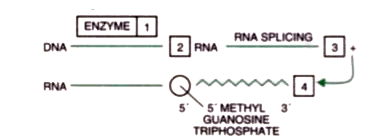Give an account of post transcriptional modifications of a eukaryotic mRNA.
Step-by-Step Text Solution:
1. Understanding Transcription:
- Transcription is the process where DNA is used as a template to synthesize messenger RNA (mRNA). This is a crucial step in the central dogma of molecular biology, which outlines the flow of genetic information from DNA to RNA to protein.
2. Primary Transcript Formation:
- The initial mRNA synthesized from DNA is known as heterogeneous nuclear RNA (hnRNA). This primary transcript contains both coding regions (exons) and non-coding regions (introns).
3. Need for Post-Transcriptional Modifications:
- The primary transcript (hnRNA) is non-functional in its original form because it contains introns that need to be removed. Therefore, post-transcriptional modifications are necessary to convert hnRNA into functional mRNA.
4. Key Post-Transcriptional Modifications:
- There are two main types of post-transcriptional modifications: Capping and Tailing.
5. Capping:
- Capping involves the addition of a modified guanine nucleotide, specifically 7-methylguanylate (m7G), to the 5' end of the mRNA. This cap protects the mRNA from degradation and assists in ribosome binding during translation.
6. Tailing:
- Tailing refers to the addition of a poly-A tail, which consists of a stretch of adenine nucleotides added to the 3' end of the mRNA. This tail also protects the mRNA from degradation and aids in the export of mRNA from the nucleus to the cytoplasm.
7. Final mRNA Product:
- After these modifications, the mRNA is now mature and functional, ready for translation into proteins. The introns are removed, and only the exons remain in the final mRNA.
8. Significance in Eukaryotic Cells:
- It is important to note that these post-transcriptional modifications occur only in eukaryotic cells. In prokaryotic cells, mRNA is produced directly from DNA without introns, and thus, these modifications are not necessary.
- Transcription is the process where DNA is used as a template to synthesize messenger RNA (mRNA). This is a crucial step in the central dogma of molecular biology, which outlines the flow of genetic information from DNA to RNA to protein.
- The initial mRNA synthesized from DNA is known as heterogeneous nuclear RNA (hnRNA). This primary transcript contains both coding regions (exons) and non-coding regions (introns).
- The primary transcript (hnRNA) is non-functional in its original form because it contains introns that need to be removed. Therefore, post-transcriptional modifications are necessary to convert hnRNA into functional mRNA.
- There are two main types of post-transcriptional modifications: Capping and Tailing.
- Capping involves the addition of a modified guanine nucleotide, specifically 7-methylguanylate (m7G), to the 5' end of the mRNA. This cap protects the mRNA from degradation and assists in ribosome binding during translation.
- Tailing refers to the addition of a poly-A tail, which consists of a stretch of adenine nucleotides added to the 3' end of the mRNA. This tail also protects the mRNA from degradation and aids in the export of mRNA from the nucleus to the cytoplasm.
- After these modifications, the mRNA is now mature and functional, ready for translation into proteins. The introns are removed, and only the exons remain in the final mRNA.
- It is important to note that these post-transcriptional modifications occur only in eukaryotic cells. In prokaryotic cells, mRNA is produced directly from DNA without introns, and thus, these modifications are not necessary.
Topper's Solved these Questions
- MOLECULAR BASIS INHERITANCE BOOK - NCERT EXEMPLAR ENGLISHCHAPTER - MOLECULAR BASIS INHERITANCE EXERCISE - Short Type Answer Questions
23 Videos
- MICROBES IN HUMAN WELFARE BOOK - NCERT EXEMPLAR ENGLISHCHAPTER - MICROBES IN HUMAN WELFARE EXERCISE - Long Answer Type Questions
6 Videos
- ORGANISMS AND POPULATIONSBOOK - NCERT EXEMPLAR ENGLISHCHAPTER - ORGANISMS AND POPULATIONSEXERCISE - Long Answer Type Questions
12 Videos
Similar Questions
Which of the following events take place during post - transcriptional modification in eukaryotes ?
View SolutionGive a brief account of HVZ reaction.
View SolutionExplain the post transcriptional modifications the hn-RNA undergoes in eukaryotic cell.
View SolutionDescribe post transcriptional processing of RNA in eukaryotes.
View SolutionGive an account of hormonal control of digestion.
View SolutionGiven below is a sequence of steps of transcription in a eukaryotic cell. Fill up the blanks (1, 2, 3, 4) left in the sequence.

View SolutionGiven below is a sequence of steps of transcription in a eukaryotic cell. Fill up the blanks (1,2,3,4) left in the sequence .

View SolutionIdentify the correct answer with respect to RNA interference (RNAi)
P. It is an event of post-transcriptional gene silencing
Q. It works through RNA induced silencing complex
View SolutionGive an account of the different types of soil water
View SolutionGive a brief account of significance of transpiration.
View Solution
